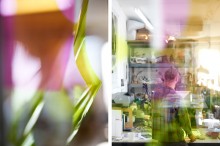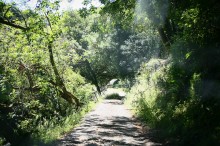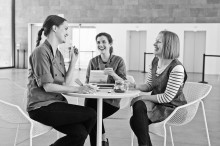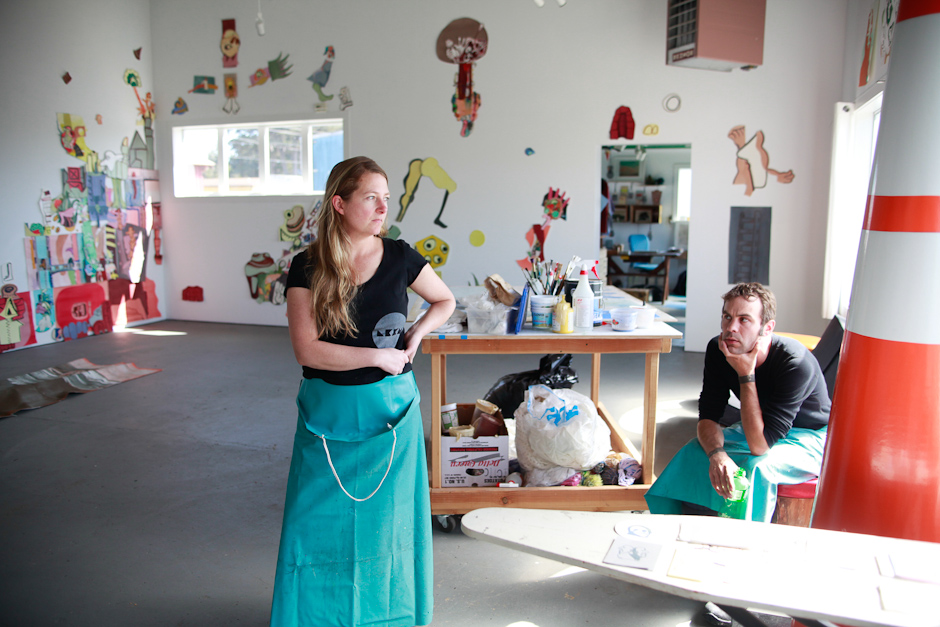
Anne Beck & The Lost Coast Culture Machine

“We took risks, we knew we took them; things have come out against us, and therefore we have no cause for complaint, but bow to the will of Providence, determined still to do our best…” In 1912 British explorer Robert Falcon Scott wrote those words in his diary during an ill-fated South Pole expedition. I first read about the Heroic Age of Antarctic Exploration a few years ago and became fascinated with the many expeditions launched during this period, and Scott’s words in particular resonated strongly and managed to captivate my memory. Full of humility, hardiness and heartbreak, Scott’s diary entry reveals an unflinching look at the nature of risk and the power of holding out hope.
Scott’s words cannot help but come to mind when I think about our visit with Anne Beck and the Lost Coast Culture Machine. Founded in 2010 by Anne and Dietmar Krumrey (both artists in their own right), Lost Coast Culture Machine is an artist-run contemporary art space and handmade paper mill located in Fort Bragg that hosts exhibitions, performances, talks, films, collaborative projects and residencies, with a focus on interdisciplinary and sustainable creative practice. Together Anne and Dietmar make fine art papers and stationery by using locally harvested plants, including highly invasive pampas grass, and unsellable clothes and linens saved from landfill. Having moved out to Fort Bragg from New York and Michigan respectively, Anne and Dietmar hoped that LCCM would enable compelling creative experiences and spark new interest in contemporary art among the locals and surrounding Mendocino communities… and due to their steadfast conviction and enthusiasm they have managed to do so to some degree. But there experience hasn’t been without hiccups, and has in many ways proved to be much more challenging then they had expected.
While visiting with Anne and Dietmar, we sat in the main gallery space, surrounded by the colorful cartoon-like work of Pauline Halper and the sculptures of Bob Rhoades in the small adjacent room with the bright afternoon sunlight coming in through the windows. Outside the coastal wind whipped through the trees and fog began to roll in. We talked intently with Anne and Dietmar for a good while— and to be honest, it didn’t take long to realize that they were stretched thin and that running LCCM all on their own has taken a great deal of effort, and has not been without sacrifice. They both talked at length about what a risky venture this had been— creatively, professionally, financially, and personally— and just how unexpected the pitfalls and challenges were, and that even what they knew they were up against from the start had proved to be more difficult than imagined. One of the main issues for LCCM is a lack of engagement and support from the local community— the rugged town of Fort Bragg and its surrounding areas just doesn’t seem to know how to participate with the contemporary art work, though LCCM continues to bring in interesting local and visiting artists for shows and residencies, along with varied public programs and events. While LCCM is not without some enthusiastic supporters, it’s a bit of a rare bird out on California’s Lost Coast.
Despite their challenges and LCCM’s uncertain future, both Anne and Dietmar showed no regret— instead they seemed determined to ensure that LCCM flourishes. In talking with them it was obvious that they knew from the beginning that starting an art space in a small town in Mendocino was a risk… but they were ready to struggle and fight for it to work, somehow, any which way. Though their trajectory has not necessarily been the easiest, they are in fact making it work. Visiting them reminded me that the value of risk is not always in the immediate reward, but rather it is found in the new ways we are pushed to think and act in order to stay on a path we believe in no matter what. I have the greatest admiration for anyone who, as Theodore Roosevelt said, “ … is actually in the arena, whose face is marred by dust and sweat and blood; who strives valiantly… who does actually strive to do the deeds… so that his place shall never be with those cold and timid souls who neither know victory nor defeat.”
It’s only fitting, too, that so much of Anne’s own artwork considers liminal landscapes, unpredictable environmental and psychological states, and the toolkits we create to navigate them. I think LCCM and the considerable efforts behind it speak to Anne and Dietmar’s “toolkits”— their perseverance and faith in the importance of art.

Installation of floating branches by local artist Bob Rhoades in the Lost Coast Culture Machine’s project space.
How would you describe your subject matter or the content of your work?
Here’s my rigid statement: My work chronicles the collision of civilization, the land, and its inhabitants. Through hybrid and incongruent landscapes and anthropomorphized animals and plants delivering dialogue or insinuating thought, I aim to weave whimsical tales of divergent concepts of land-use: urban and rural, developed and conserved, cultivated and paved, sustained and depleted. But I’m veering from that into creating a fantastical realm, half post-apocalyptic, half escape from social/political ills, half utopia, three halves being appropriate for these new terrains. And I’m also focusing on objects, tools for survival within these realms: survival kits, tinder bags, quilts, maps, navigational charts.


What mediums do you work with?
Painting/drawing/collage.
Sewing, plaster, small sculpture.
Vinyl/magnetic material installation.
Video, digital photography.
Print – primarily inkjet.
Books.
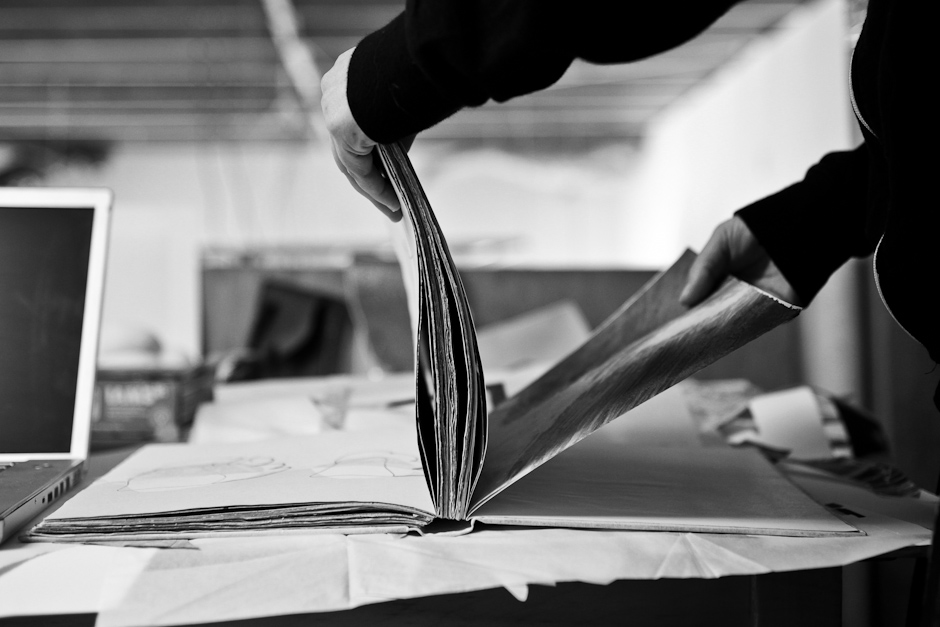
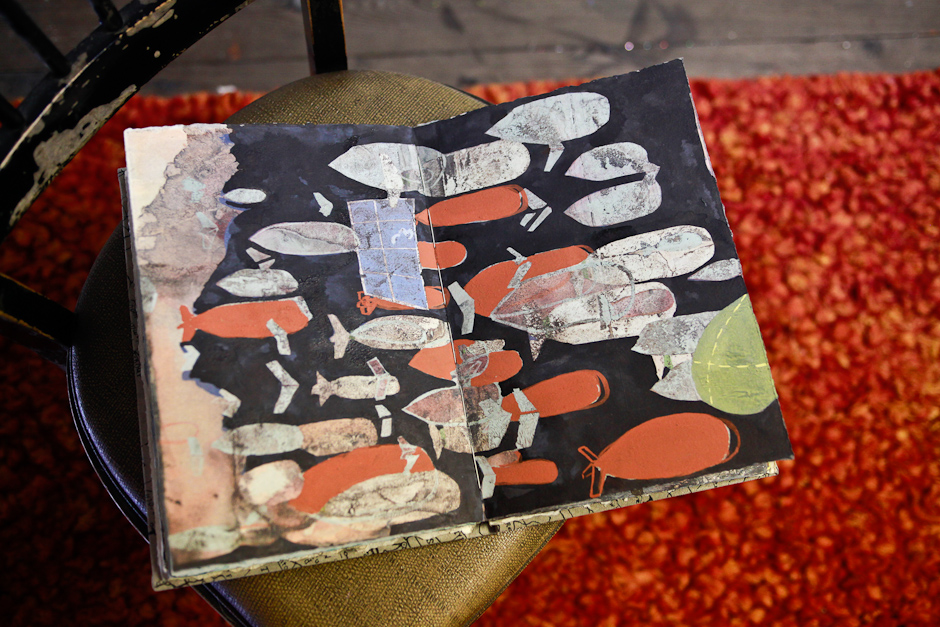
You have a varied art practice in which you employ an array of materials and mediums— how do you think this benefits your work overall? Are there pitfalls?
Certainly there are pitfalls – I have projects in various states of realization all over the place. It’s a bit schizophrenic and disjointed. It also makes it very difficult to write or talk about my work— to wrap it all up in a neat package. Benefits?… hmmm. It’s just what I do. I see something, especially something that I might throw away or has been discarded by someone else, and immediately my brain starts spinning around what it might be useful for or what could be made of it. I do think that it benefits my work, or that at least the process gels with the intent in that I am trying to figure things out, carve out some answers and the more perspectives and approaches to the questions, the more likely I might see the parts coming together in new different ways, enlightening ways. I like to compare it to dreams – piecing different elements of memory and consciousness together to try to gain perspective on certain situations, feelings, or whatever in order to learn about or better understand them.

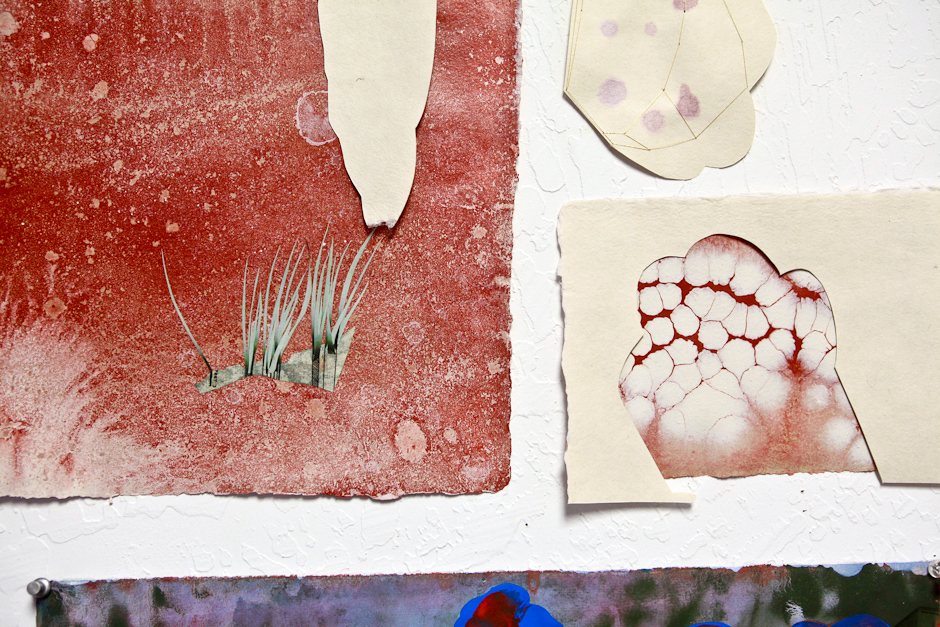
Before moving to Mendocino County you lived in New York for a long time and worked in the film and television industry– what prompted the move?
I was very ready to leave the city – to get away from asphalt, Wall Street, Madison Avenue, etc. and spent the year prior to the move searching for a tenure-track teaching job. The only job I was offered was in North Dakota, which could have been okay, but meanwhile, my mom, who lived here and had been diagnosed with lung cancer the year before, was seriously struggling and my brother (who lived out here at the time) asked super humbly if I’d come help take care of her. After much deliberation, Dietmar and I decided to move here, take care of my mom and then maybe go to the Bay area or up to Portland or Seattle.
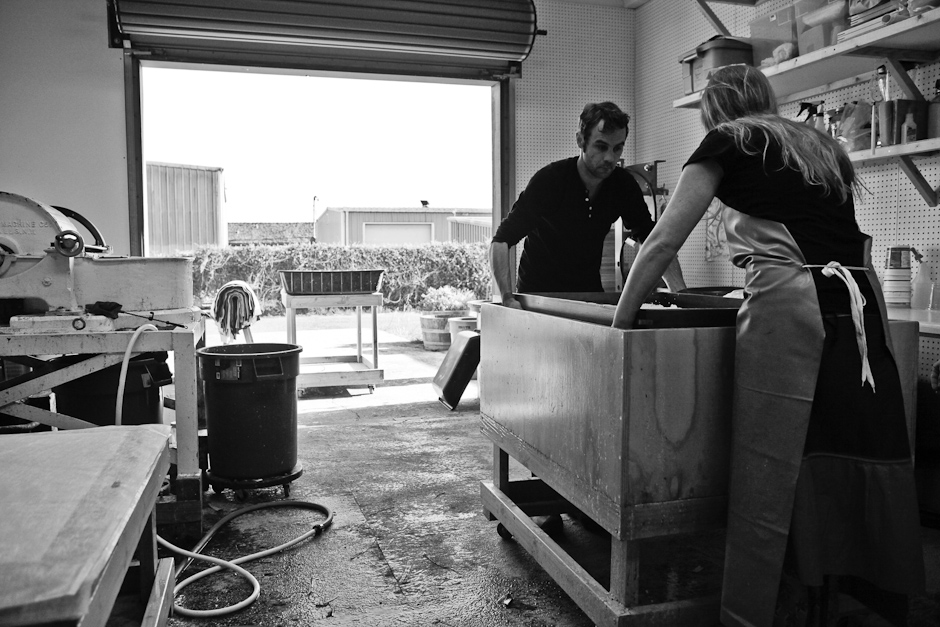
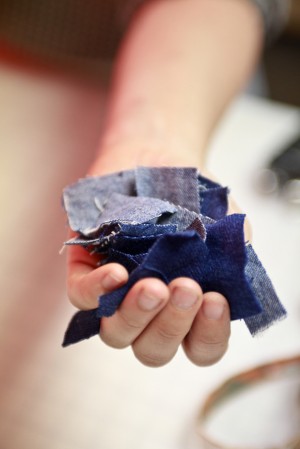
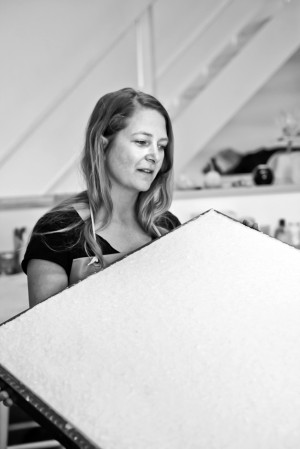
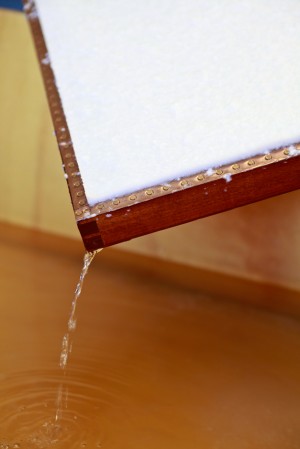
Anne and her collaborator Dietmar Krumrey making paper.
Tell us how Lost Coast Culture Machine began and what it is all about?
My mom died two weeks after we moved here and I think we went a bit crazy as a result of a huge move and handling everything that needed handling. We decided – consciously or not – to stay put for a while and if we were going to stay here on the coast, we wanted some way to engage with the contemporary art world/practice here. We also found that though there is a great deal of art here, the bulk of it is geared to tourists – so rather not challenging. There were incidences of meeting locals who were shocked by the notion that art could be anything other than pretty decoration or could address social / political/environmental issues. We felt the need to show that to be incorrect.

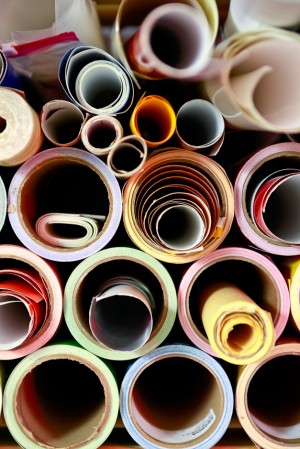

What are you presently inspired by— are there particular things you are reading, listening to or looking at to fuel your work?
Traditional and sustainable practices: I think like many artists today, I’m looking at old knowledge, traditional practices— information that has been supplanted by industry, grocery stores, and technologies developed for the sake of efficiency, but maybe not sustainability. Mendocino County is great for this sort of thing; lots of the knowledge hasn’t been lost— people harvest acorns, seasalt, can their own wildcaught fish, grow their own food and medicine, and have been doing so for generations. I’m learning from the Mechanix Illustrated How-to-do-it Encyclopedia from 1961, and the Foxfire books techniques like how to start a fire by friction, and helpful hints like “In Emergency, Almost anything that swims, walks, or crawls can be eaten.” At Lost Coast Culture Machine we have a hand made paper mill – connecting contemporary practice with its roots in a technology developed to broadcast culture – so I’ve been doing a lot of research on local native and invasive plants to use for fiber & natural dyes.
Land sites: The GP Millsite is a 400 acre, paved, pampas grass strewn, depleted industrial landscape, off limits to the public, that occupies the entire coast line of Fort Bragg. It’s owned by Koch Industries and has been sitting empty for over 10 years, waiting for reclamation efforts, rezoning, settlement of lawsuits, and resolutions with tribal councils. For me, it symbolizes both the History of America from European Settlement/Eradication of the Indians to Post Extraction-Economy Depression, and the site of Future New Terrains. I’m also looking at wild other-worldly landscapes like the ancient mineral formations at Luray Caverns in Virginia, and ice formations in the Arctic.
Pop music: Though in theory I despise the top 40, in practice I find that it soothes my central nervous system. Pop offers a shiny, sparkly respite from the critical. I sense there’s something to be learned from pop music’s seductiveness to carry into the unknown terrains of tomorrow.


Collage installation by artist Pauline Halper in the Lost Coast Culture Machine’s main Gallery.
What does having a physical space to make art in mean for your process, and how do you make your space work for you?
It’s absolutely crucial to be able to see what I’ve made and let it speak back to me – to see it all together, make links between the components, find the next path.
Do you have a motto?
“I don’t know” tends to be my refrain, for better or worse. Maybe it’s more a tick than a motto. I could benefit from something more affirming. I was recently going through my grandparent’s attic – back in Virginia – instructed by my uncles to sort through all the crafty/sewing/knitting stuff – and I ran across a report from one of my grandfather’s jobs – on the bottom of each page it said “We are going to win.” I’ve started to use that in correspondence about LCCM.

Are you involved in any upcoming shows or events? Where and when?
Exquisite History III: The Visionary Workbook, book launch and collaborative installation, Center Art Gallery, Calvin College, Grand Rapids, MI, November 1 – December 17, 2013. Traveling in 2014 to the University of Virginia, UNC Greensboro, & the SGC International Conference in San Francisco, March 26 -29, 2014.
www.sgcisanfrancisco.org
Drawing More, an international video and print project, currently screening in the Niche in the Fine Arts Library at the University of Virginia.
Where can people see your work?
www.anastomose.net (promised to be updated soon!)
Collaborative project with Dietmar Krumrey: Lost Coast Culture Machine
Drawing Center Viewing Program
Walking Harp, a blog to which I post every two weeks.
STATE, published by Brooklyn Arts Press:
www.brooklynartspress.com/portfolio/state-by-anne-beck/
Review:
www.hyperallergic.com/16094/decoding-anne-beck/
Installation shots of Exquisite History II: The New World in Jyvaskyla, Finland,(precursor to upcoming Calvin College show).
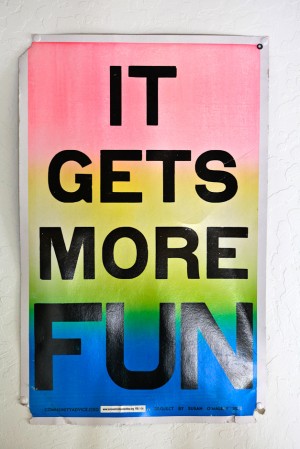
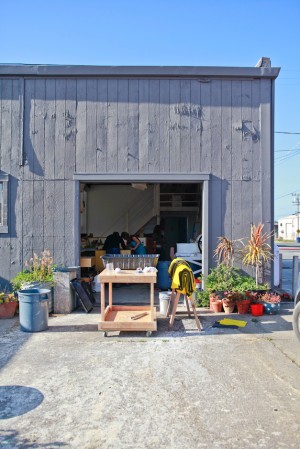

Poster by artist Susan O’Malley as part of the project Community Advice.

